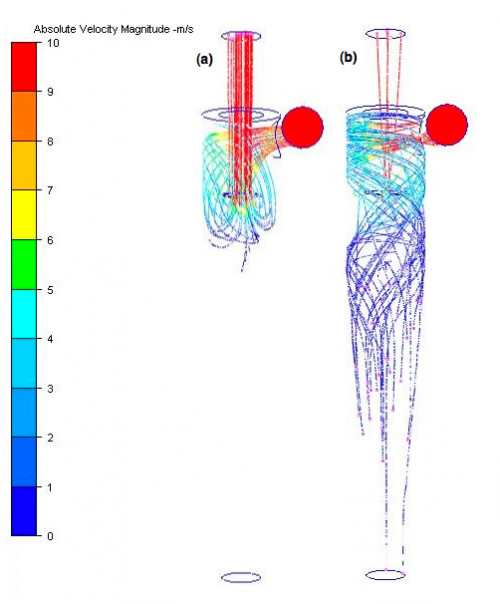Inertial Filtration of Lunar Dust
In collaboration with researchers at NASA Glenn Research Center, Carthage students designed, built, and flew a test-bed for studying the efficiency of cyclonic filtration of lunar regolith dust simulants in low gravity environments.
Experiment Background

An air cyclone is a device that separates particles from a carrier air stream by means of a centrifugal force acting on the particles. Dust particles, initially entrained in the air flow, enter a tangential in- let near the top of the cyclone, and follow the downward spiral of the air vortex. Centrifugal force and inertial effects act on the particles to move them outward toward the inner wall of the cyclone where they are trapped in the boundary flow. Trapped particles eventually move down the inner wall and are collected in a dust cup at the base of the cyclone while the air flow reverses direction near the base of the cyclone, and exits the through the vortex finder at the top of the cyclone. The viability of air cyclones in the lunar environment is contingent on the degree to which gravitational settling is the dominant mechanism of particle collection. This is the question addressed in the present work
The Carthage team developed theoretical models for the efficiency of cyclonic filtration in low gravity and proposed, designed, and built a flight experiment to test the efficiency of cyclonic filtration of lunar dust simulants in low-gravity environments. The team also conducted extensive computational fluid dynamics (CFD) modeling of the inertial filtration process. Results of both CFD and analytical modeling are in agreement with the flight data, and confirm the efficacy of inertial filtration in low-gravity conditions.
Flight Campaigns
NASA SEED 2008 and subsequent NASA GRC Research campaigns
Student Involvement
Erin Martin, Caitlin Pennington, Emily Sorensen, Isa Fritz, Bradley Frye
Posters and Presentations
Computational Fluid Dynamics Model of a Cyclone Separator
Reports and Publications
Reduced Pressure Cyclone Separation Studies using Synthetic Lunar Regolith
(Mackey, J. R., Agui, J. H., Crosby, K. M., Frye, B., Sietz, T.), Symposium Proceedings of the 40th International Conference on Environmental Systems, Barcelona, Spain, July, (2010).
Computational Fluid Dynamical Model of a Cyclone Separator in Microgravity
(Crosby, K. M., Frye, B.), Proceedings of the 18th Annual Wisconsin Space Grant: Hubble and Beyond (2008).
Measurements of the Collection Efficiency of an Air Cyclone in Lunar Gravity
(Crosby, K. M., Agui, J., Pennington, C., Sorensen, E., Martin, E., Fritz, I., Frye, B.), Proceedings of the Wisconsin Space Grant (2008).
Inertial Filtration of Lunar Dust in Reduced Gravity (Proceedings Abstract)
(Crosby, K. M., et al.), Report of the Joint Annual Meeting of LEAG-ICEUM-SRR (2008).

